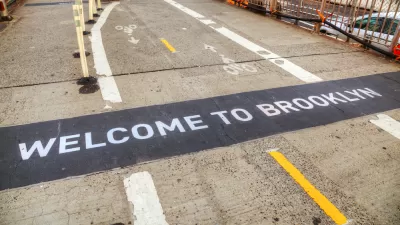Matt Bevilacqua looks at the real story behind headlines making news this week regarding the "fastest-gentrifying neighborhoods in the United States."
This week, The Atlantic Cities and The Washington Post both picked up on a story featured in the blog of the Thomas B. Fordham Institute, a non-profit think tank dedicated to education policy. The post, written by Mike Petrilli, the organization's executive vice president, "culled Census data and made a list of the top 25 ZIP codes in the country that have seen the largest increases in the percentage of white residents between 2000 and 2010" to develop a chart of what he called "the fastest-gentrifying neighborhoods in the United States."
Although the data gathered by Petrilli - "who readily admits that his expertise lies in education, not demographics" - includes some significant information, Bevilacqua rightly points out that the post's core conceit, that "more
white people automatically translates to gentrification," deserves to be challenged.
As Bevilacqua explains, "Undoubtedly, race and class in the U.S. are linked in a
complex and pretty irretrievable way. Nonetheless, they're not one in
the same. Washington, D.C. has seen an influx of middle-class black
residents whose presence has changed the economic landscape of certain
traditionally low-income neighborhoods - or, to put it another way, black gentrifiers. As the New York Times reported several years ago, this has even happend [sic] in Harlem."
"Which
isn't to say that gentrification is wholly about socioeconomic status
to the exclusion of race, either. (For an interesting take on just how
central race is to the topic, check this March 2011 blog post
by Kenyon Farrow.) It's just that any responsible discussion on
something as divisive and widely misunderstood as gentrification
shouldn't fail to take a comprehensive look at the issue."
FULL STORY: Gentrification: Not Only About White People

Alabama: Trump Terminates Settlements for Black Communities Harmed By Raw Sewage
Trump deemed the landmark civil rights agreement “illegal DEI and environmental justice policy.”

Study: Maui’s Plan to Convert Vacation Rentals to Long-Term Housing Could Cause Nearly $1 Billion Economic Loss
The plan would reduce visitor accommodation by 25% resulting in 1,900 jobs lost.

Why Should We Subsidize Public Transportation?
Many public transit agencies face financial stress due to rising costs, declining fare revenue, and declining subsidies. Transit advocates must provide a strong business case for increasing public transit funding.

Wind Energy on the Rise Despite Federal Policy Reversal
The Trump administration is revoking federal support for renewable energy, but demand for new projects continues unabated.

Passengers Flock to Caltrain After Electrification
The new electric trains are running faster and more reliably, leading to strong ridership growth on the Bay Area rail system.

Texas Churches Rally Behind ‘Yes in God’s Back Yard’ Legislation
Religious leaders want the state to reduce zoning regulations to streamline leasing church-owned land to housing developers.
Urban Design for Planners 1: Software Tools
This six-course series explores essential urban design concepts using open source software and equips planners with the tools they need to participate fully in the urban design process.
Planning for Universal Design
Learn the tools for implementing Universal Design in planning regulations.
Caltrans
Smith Gee Studio
Institute for Housing and Urban Development Studies (IHS)
City of Grandview
Harvard GSD Executive Education
Toledo-Lucas County Plan Commissions
Salt Lake City
NYU Wagner Graduate School of Public Service




























